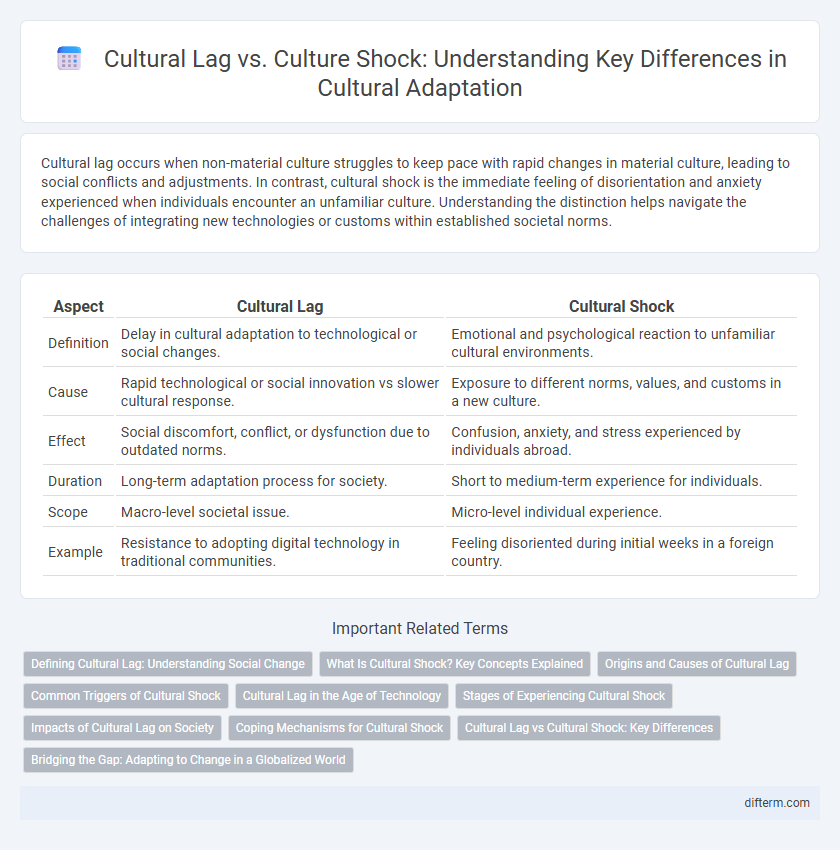Cultural lag occurs when non-material culture struggles to keep pace with rapid changes in material culture, leading to social conflicts and adjustments. In contrast, cultural shock is the immediate feeling of disorientation and anxiety experienced when individuals encounter an unfamiliar culture. Understanding the distinction helps navigate the challenges of integrating new technologies or customs within established societal norms.
Table of Comparison
| Aspect | Cultural Lag | Cultural Shock |
|---|---|---|
| Definition | Delay in cultural adaptation to technological or social changes. | Emotional and psychological reaction to unfamiliar cultural environments. |
| Cause | Rapid technological or social innovation vs slower cultural response. | Exposure to different norms, values, and customs in a new culture. |
| Effect | Social discomfort, conflict, or dysfunction due to outdated norms. | Confusion, anxiety, and stress experienced by individuals abroad. |
| Duration | Long-term adaptation process for society. | Short to medium-term experience for individuals. |
| Scope | Macro-level societal issue. | Micro-level individual experience. |
| Example | Resistance to adopting digital technology in traditional communities. | Feeling disoriented during initial weeks in a foreign country. |
Defining Cultural Lag: Understanding Social Change
Cultural lag refers to the period of adjustment when non-material culture struggles to keep pace with changes in material culture, resulting in social dissonance and adaptation challenges. This concept highlights the delayed response of beliefs, values, and norms compared to technological innovations or economic shifts. Understanding cultural lag is essential for analyzing how societies experience and manage transitions during rapid social change.
What Is Cultural Shock? Key Concepts Explained
Cultural shock refers to the feelings of confusion, anxiety, and disorientation experienced when encountering a significantly different culture, often resulting from differences in language, customs, or social norms. Key concepts include the stages of cultural shock: honeymoon, frustration, adjustment, and acceptance, which describe the emotional journey individuals undergo while adapting to a new cultural environment. Understanding cultural shock helps individuals and organizations develop strategies for smoother cultural adaptation and effective intercultural communication.
Origins and Causes of Cultural Lag
Cultural lag originates from the asynchronous pace of change between material and non-material culture, where technological advancements outpace societal norms, values, and laws. This phenomenon occurs as communities struggle to adapt their beliefs and social practices to new innovations, resulting in a temporary disjunction between cultural elements. The root causes include rapid technological development, resistance to change, and the complexity of altering deeply ingrained cultural frameworks.
Common Triggers of Cultural Shock
Common triggers of cultural shock include language barriers, unfamiliar social norms, and differing communication styles that challenge one's ability to adapt. Sudden exposure to distinct values, traditions, or behaviors often causes feelings of confusion, disorientation, and frustration. Understanding these triggers is essential to mitigate cultural shock and facilitate smoother cultural integration.
Cultural Lag in the Age of Technology
Cultural lag occurs when technological innovations outpace the ability of social institutions and cultural norms to adapt, creating a gap between material culture and non-material culture. In the age of technology, rapid advancements in digital communication, artificial intelligence, and biotechnology outstrip existing legal frameworks, ethical standards, and societal values, leading to social disorientation and resistance. This delay in cultural adaptation results in conflicts, misunderstandings, and challenges in governance, highlighting the critical need for proactive cultural evolution alongside technological progress.
Stages of Experiencing Cultural Shock
Experiencing cultural shock involves distinct stages: the honeymoon phase characterized by fascination and excitement towards a new culture, followed by the frustration phase where differences cause confusion and anxiety, leading to feelings of alienation. The adjustment phase emerges next, marked by gradual adaptation and increased understanding of cultural norms, culminating in the acceptance stage where individuals integrate and find comfort within the new cultural environment. Cultural lag differs as it refers to the delay in cultural adaptation to technological or social changes, not the emotional or psychological process of cultural shock.
Impacts of Cultural Lag on Society
Cultural lag occurs when technological advancements outpace societal norms and values, causing disruptions in social behavior and institutions. This lag can lead to conflicts, misunderstandings, and resistance to change within communities, affecting social cohesion and adaptation. The persistent gap between innovation and cultural adjustment often results in economic disparities and challenges in policy-making.
Coping Mechanisms for Cultural Shock
Cultural shock triggers emotional and psychological stress when individuals encounter unfamiliar cultural environments, requiring effective coping mechanisms such as seeking social support, learning the new culture actively, and maintaining open-mindedness to facilitate adjustment. Unlike cultural lag, which describes the delay in cultural adaptation to technological or social changes, cultural shock demands immediate emotional resilience and practical strategies to overcome feelings of alienation. Utilizing language acquisition, participating in cultural activities, and developing stress management techniques help mitigate cultural shock and promote smoother integration into new cultural settings.
Cultural Lag vs Cultural Shock: Key Differences
Cultural lag occurs when material culture advances faster than non-material culture, creating a delay in societal adjustment to new technologies or innovations. Cultural shock involves the emotional and psychological disorientation experienced when encountering an unfamiliar culture, often marked by confusion and anxiety. Key differences lie in cultural lag's focus on temporal adaptation gaps within a single society versus cultural shock's emphasis on immediate reactions to cross-cultural encounters.
Bridging the Gap: Adapting to Change in a Globalized World
Cultural lag occurs when technological advancements outpace societal norms, causing delays in cultural adaptation, while cultural shock results from individuals encountering profoundly different cultural environments. Bridging the gap requires fostering intercultural competence and promoting inclusive communication to ease transitions between traditional values and emerging global practices. Emphasizing education and cross-cultural exchanges accelerates adaptation, reducing misunderstandings in an interconnected world.
Cultural lag vs Cultural shock Infographic

 difterm.com
difterm.com